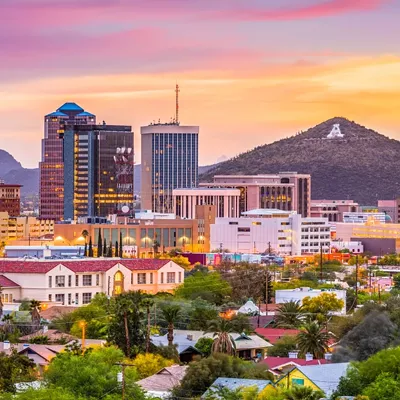Shirley Ewell Sims knew her Carter Canyon cabin had been destroyed, but she was crossing her fingers that at least her grandmother's aluminum pots and pans had survived the conflagration (see "Up in Smoke," June 26). But poking through the ash-blanketed twisted metal and cracked foundation that were the last vestiges of her 30-year-old summer home, all she found were what she called "melted blobs." Even the metal window frames had liquefied and dribbled into little pools on the ground.
Meanwhile, Charles and Carolyn Slaughter had already learned that their Fern Ridge cabin had been spared, unlike most of the neighboring structures. Their cabin, topped with asbestos shingles and lacking a combustible wood deck, simply smelled smoky. The pines downhill from the cabin hadn't been damaged too severely, but those up the hill were now nothing more than a charcoal grove dotted with stone chimneys overlooking ash piles that used to be homes.
The Forest Service opened the area to cabin and business owners July 17, and over the next several days, the place was swarming with families, claims adjustors and journalists surveying the damage. Perky Red Cross volunteers and various service agencies greeted residents under yellow-and-white canvas awnings erected in what little remained of the village of Summerhaven, issuing rakes and buckets and rubber boots and food and water donated by Tucson businesses and individuals.
On Saturday morning, up the road to Ski Valley, workers were piling up bales of straw and sacks of grass seed to distribute to homeowners, while a small fixed-wing plane circled overhead, re-seeding the federal lands. Later, a couple of helicopters buzzed the airspace between the charred treetops and the gathering clouds, dusting the area with straw in an effort to secure the ash and topsoil before rains could wash it all down the canyons.
But it will take more than crop dusters and hardware-store handouts to heal the Catalinas. Debatable federal forest policy, confusing signals from the county that suggest fast-track reconstruction allowances may be hindered by tougher building codes, and growing homeowner resentment over how the Aspen Fire was managed form the new, dark clouds settling over Coronado National Forest.
THINGS LOOK FAIRLY normal along the lowest three miles of the Catalina Highway. Eventually, some blackened plants appear along the left side of the road, but that's evidence of crew-ignited backburn, not the "real" fire. Then round the bend just above Molino Basin, and you face total devastation: stick-studded black slopes.
Many stretches along the upper highway still look healthy, aside from a bit of ground-level scorching, but then you come to a place like the turnoff to the back road to Oracle, just below Summerhaven, and it smells like you've stuck your face into an ashtray. The quilted pattern of devastation and preservation continues well off the highway, along the dirt roads leading to cabin sites.
"Across the street from us," says Coy Sims, "the cabin isn't even scorched. Everything around it is burned, but that cabin's just as perfect as can be. It's unreal.
"The locust trees on one of our other neighbor's property were burned to the roots, but they've already grown back a foot high. We think a lot of our own trees will live, too, especially the big ones, where the bark isn't burned all the way to the wood."
Insurance agents have been taking inventory of the trees on the Sims' privately owned property, not just the contents of the cabin. But whatever insurance money Coy and Shirley walk away with, they're not yet sure that they want to rebuild.
"We're waiting to see what the county regulations are like," says Coy. "They want to make everything fireproof, but that could make it too expensive for some people to rebuild."
Meanwhile, Shirley is talking about incorporating the fused and melted mystery objects she finds into an experimental mural, or assembling a sculpture with her granddaughter. "We might as well try to make something positive out of nothing," she says.
For their part, Charles and Carolyn Slaughter probably won't need more than a few dollars to have their despised old carpet cleaned and their mold-contaminated refrigerator replaced. So Charles, as a member of his local water board, spent most of last weekend refilling the 20,000-gallon water tanks at Bear Wallow and Sykes Knob, and checking for leaks where the Forest Service's anti-erosion trenching may have cut into pipes.
Charles tramped around the incinerated structures, ash crunching softly underfoot.
"Here we are," he said as he approached his cabin, "not lost--yet."
One of his neighbors wasn't so lucky, even though the surrounding property is unburned. The neighbor has privately suggested that the fire crews let their backburn get away from them, and that's what destroyed his cabin, not the Aspen Fire. Charles doubts this theory, but he and the Simses do question the overall management of the fire, particularly in the early days.
"At first. the fire went north from Marshall Peak in a hell of a rush," says Charles, "and there was no immediate threat to the cabins, so the crews put a lot of effort on the north and west sides of the fire, but nothing special here in the southeast. But how did they overlook the notion that the wind might shift to the west, which is the prevailing direction up here? They had a couple of days and could have opened up the next ridge over, but they didn't go in there until the fire got out of hand."
Still, Charles thinks the Aspen fire has taught a necessary lesson.
"You look around Carter Canyon and you see that the trees are still there, but the cabins are gone," he says. "Cabins are clearly incompatible with the forest."











